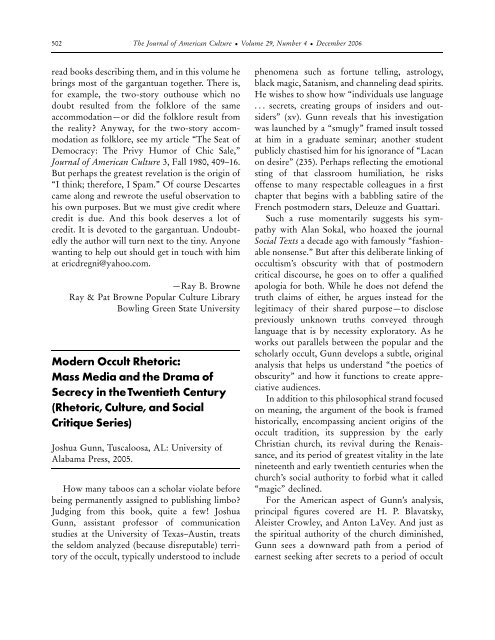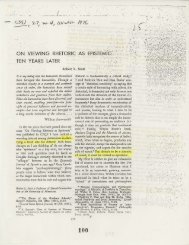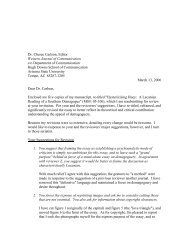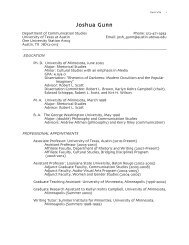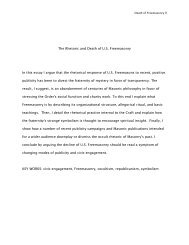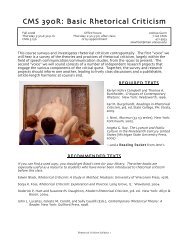Modern Occult Rhetoric: Mass Media and the Drama of Secrecy in ...
Modern Occult Rhetoric: Mass Media and the Drama of Secrecy in ...
Modern Occult Rhetoric: Mass Media and the Drama of Secrecy in ...
Create successful ePaper yourself
Turn your PDF publications into a flip-book with our unique Google optimized e-Paper software.
502 The Journal <strong>of</strong> American Culture Volume 29, Number 4 December 2006read books describ<strong>in</strong>g <strong>the</strong>m, <strong>and</strong> <strong>in</strong> this volume hebr<strong>in</strong>gs most <strong>of</strong> <strong>the</strong> gargantuan toge<strong>the</strong>r. There is,for example, <strong>the</strong> two-story outhouse which nodoubt resulted from <strong>the</strong> folklore <strong>of</strong> <strong>the</strong> sameaccommodation—or did <strong>the</strong> folklore result from<strong>the</strong> reality? Anyway, for <strong>the</strong> two-story accommodationas folklore, see my article ‘‘The Seat <strong>of</strong>Democracy: The Privy Humor <strong>of</strong> Chic Sale,’’Journal <strong>of</strong> American Culture 3, Fall 1980, 409–16.But perhaps <strong>the</strong> greatest revelation is <strong>the</strong> orig<strong>in</strong> <strong>of</strong>‘‘I th<strong>in</strong>k; <strong>the</strong>refore, I Spam.’’ Of course Descartescame along <strong>and</strong> rewrote <strong>the</strong> useful observation tohis own purposes. But we must give credit wherecredit is due. And this book deserves a lot <strong>of</strong>credit. It is devoted to <strong>the</strong> gargantuan. Undoubtedly<strong>the</strong> author will turn next to <strong>the</strong> t<strong>in</strong>y. Anyonewant<strong>in</strong>g to help out should get <strong>in</strong> touch with himat ericdregni@yahoo.com.—Ray B. BrowneRay & Pat Browne Popular Culture LibraryBowl<strong>in</strong>g Green State University<strong>Modern</strong> <strong>Occult</strong> <strong>Rhetoric</strong>:<strong>Mass</strong> <strong>Media</strong> <strong>and</strong> <strong>the</strong> <strong>Drama</strong> <strong>of</strong><strong>Secrecy</strong> <strong>in</strong> <strong>the</strong>Twentieth Century(<strong>Rhetoric</strong>, Culture, <strong>and</strong> SocialCritique Series)Joshua Gunn, Tuscaloosa, AL: University <strong>of</strong>Alabama Press, 2005.How many taboos can a scholar violate beforebe<strong>in</strong>g permanently assigned to publish<strong>in</strong>g limbo?Judg<strong>in</strong>g from this book, quite a few! JoshuaGunn, assistant pr<strong>of</strong>essor <strong>of</strong> communicationstudies at <strong>the</strong> University <strong>of</strong> Texas–Aust<strong>in</strong>, treats<strong>the</strong> seldom analyzed (because disreputable) territory<strong>of</strong> <strong>the</strong> occult, typically understood to <strong>in</strong>cludephenomena such as fortune tell<strong>in</strong>g, astrology,black magic, Satanism, <strong>and</strong> channel<strong>in</strong>g dead spirits.He wishes to show how ‘‘<strong>in</strong>dividuals use language. . . secrets, creat<strong>in</strong>g groups <strong>of</strong> <strong>in</strong>siders <strong>and</strong> outsiders’’(xv). Gunn reveals that his <strong>in</strong>vestigationwas launched by a ‘‘smugly’’ framed <strong>in</strong>sult tossedat him <strong>in</strong> a graduate sem<strong>in</strong>ar; ano<strong>the</strong>r studentpublicly chastised him for his ignorance <strong>of</strong> ‘‘Lacanon desire’’ (235). Perhaps reflect<strong>in</strong>g <strong>the</strong> emotionalst<strong>in</strong>g <strong>of</strong> that classroom humiliation, he risks<strong>of</strong>fense to many respectable colleagues <strong>in</strong> a firstchapter that beg<strong>in</strong>s with a babbl<strong>in</strong>g satire <strong>of</strong> <strong>the</strong>French postmodern stars, Deleuze <strong>and</strong> Guattari.Such a ruse momentarily suggests his sympathywith Alan Sokal, who hoaxed <strong>the</strong> journalSocial Texts a decade ago with famously ‘‘fashionablenonsense.’’ But after this deliberate l<strong>in</strong>k<strong>in</strong>g <strong>of</strong>occultism’s obscurity with that <strong>of</strong> postmoderncritical discourse, he goes on to <strong>of</strong>fer a qualifiedapologia for both. While he does not defend <strong>the</strong>truth claims <strong>of</strong> ei<strong>the</strong>r, he argues <strong>in</strong>stead for <strong>the</strong>legitimacy <strong>of</strong> <strong>the</strong>ir shared purpose—to disclosepreviously unknown truths conveyed throughlanguage that is by necessity exploratory. As heworks out parallels between <strong>the</strong> popular <strong>and</strong> <strong>the</strong>scholarly occult, Gunn develops a subtle, orig<strong>in</strong>alanalysis that helps us underst<strong>and</strong> ‘‘<strong>the</strong> poetics <strong>of</strong>obscurity’’ <strong>and</strong> how it functions to create appreciativeaudiences.In addition to this philosophical str<strong>and</strong> focusedon mean<strong>in</strong>g, <strong>the</strong> argument <strong>of</strong> <strong>the</strong> book is framedhistorically, encompass<strong>in</strong>g ancient orig<strong>in</strong>s <strong>of</strong> <strong>the</strong>occult tradition, its suppression by <strong>the</strong> earlyChristian church, its revival dur<strong>in</strong>g <strong>the</strong> Renaissance,<strong>and</strong> its period <strong>of</strong> greatest vitality <strong>in</strong> <strong>the</strong> laten<strong>in</strong>eteenth <strong>and</strong> early twentieth centuries when <strong>the</strong>church’s social authority to forbid what it called‘‘magic’’ decl<strong>in</strong>ed.For <strong>the</strong> American aspect <strong>of</strong> Gunn’s analysis,pr<strong>in</strong>cipal figures covered are H. P. Blavatsky,Aleister Crowley, <strong>and</strong> Anton LaVey. And just as<strong>the</strong> spiritual authority <strong>of</strong> <strong>the</strong> church dim<strong>in</strong>ished,Gunn sees a downward path from a period <strong>of</strong>earnest seek<strong>in</strong>g after secrets to a period <strong>of</strong> occult
Book Reviews503commodification dom<strong>in</strong>ated by scary imagesra<strong>the</strong>r than esoteric language.Blavatsky was a world traveler from Ukra<strong>in</strong>ewho, <strong>in</strong> 1875, formed <strong>the</strong> Theosophical Society <strong>in</strong>New York; she circulated as a spiritualist celebritywho comm<strong>and</strong>ed special <strong>in</strong>sights <strong>and</strong> powersbased upon her study <strong>of</strong> assorted world religions.The Society still exists today <strong>and</strong> her works suchas Isis Unveiled (1877) <strong>and</strong> The Secret Doctr<strong>in</strong>e(1888), although denounced by some <strong>of</strong> hercontemporaries as ‘‘rubbish,’’ are still <strong>in</strong> pr<strong>in</strong>ttoday, rema<strong>in</strong><strong>in</strong>g important to <strong>the</strong> <strong>the</strong>osophicalstr<strong>and</strong> <strong>of</strong> New Age religions. Her rhetorical style,which was repetitive, list-laden with citations, <strong>and</strong>filled with imported terms (especially fromSanskrit), helped Blavatsky cultivate <strong>the</strong> aura <strong>of</strong>authority among her devoted, though <strong>of</strong>tenbemuddled followers. Her justification for <strong>the</strong>peculiar language was that it could transport herreaders to <strong>the</strong> <strong>the</strong>ologically ‘‘<strong>in</strong>effable,’’ <strong>the</strong> morethan-ord<strong>in</strong>aryspiritual reality that lay beyond <strong>the</strong>references <strong>of</strong> def<strong>in</strong>ite, ord<strong>in</strong>ary, or scientificlanguage. It was <strong>the</strong> promised access to secrecy,despite <strong>the</strong> obscurity, that held her readers.Aleister Crowley was a sojourner <strong>of</strong> a differentk<strong>in</strong>d. An Englishman <strong>of</strong> <strong>in</strong>dependent means, hepresented himself variously as <strong>the</strong> revealer <strong>of</strong>secrets from ancient Egyptian gods <strong>and</strong> as asatanic prankster who encouraged witchcraft,child sacrifice, <strong>and</strong> complete sexual freedom. InGunn’s read<strong>in</strong>g, Crowley encouraged his readersto make a k<strong>in</strong>d <strong>of</strong> erotic fetish <strong>of</strong> <strong>the</strong>ir experience<strong>in</strong> read<strong>in</strong>g The Book <strong>of</strong> <strong>the</strong> Law (1904; Appendix2 reproduces <strong>the</strong> full text). Cont<strong>in</strong>u<strong>in</strong>g withscholarly analogues, Gunn sees Crowley’s selfstyl<strong>in</strong>g as master <strong>of</strong> text-with-secrets <strong>in</strong> relation to<strong>the</strong> academic star system, with its ‘‘masters <strong>of</strong><strong>in</strong>terpretation’’ who carry <strong>the</strong> pretense <strong>of</strong> perceiv<strong>in</strong>g<strong>the</strong> mean<strong>in</strong>g <strong>of</strong> important texts directly,without <strong>the</strong> ta<strong>in</strong>t <strong>of</strong> preconceptions. This tendencyis identified <strong>in</strong> <strong>the</strong> older New Criticismmovement <strong>and</strong> <strong>the</strong> newer ‘‘<strong>in</strong>tr<strong>in</strong>sic criticism’’stance <strong>in</strong> <strong>the</strong> field <strong>of</strong> rhetorical studies. Yetano<strong>the</strong>r dimension <strong>of</strong> Crowley’s performancewas an anti<strong>the</strong>tical irony toward himself as expert<strong>and</strong>, even worse for his reputation, participation<strong>in</strong> pranks reported <strong>in</strong> <strong>the</strong> popular American <strong>and</strong>British press as openly crim<strong>in</strong>al or sacrilegious.Crowley’s attitudes <strong>and</strong> behavior could surviveamong a quietly anarchic elite but were fiercelydenounced when more widely known. Without<strong>the</strong> trapp<strong>in</strong>gs <strong>of</strong> Crowley’s ‘‘wickedest man <strong>in</strong> <strong>the</strong>world’’ label, America’s hermeneutic elite has alsosuffered <strong>in</strong> <strong>the</strong> exposures <strong>of</strong> postmodern vocabulary<strong>and</strong> political stances to popular scrut<strong>in</strong>y.Anton LaVey represents <strong>the</strong> low po<strong>in</strong>t <strong>in</strong> <strong>the</strong>evolution <strong>of</strong> <strong>the</strong> search for <strong>and</strong> dissem<strong>in</strong>ation <strong>of</strong>secrets. In Gunn’s account<strong>in</strong>g, LaVey is morepublicist <strong>and</strong> marketeer than <strong>in</strong>quirer. His Church<strong>of</strong> Satan (founded <strong>in</strong> 1966) <strong>and</strong> Satanic Bible(1969) are really about demystification <strong>and</strong> <strong>the</strong>assertion <strong>of</strong> a secular life orientation. The book,which rema<strong>in</strong>s <strong>in</strong> pr<strong>in</strong>t, was cobbled toge<strong>the</strong>rfrom diverse sources (<strong>in</strong>clud<strong>in</strong>g Crowley) <strong>and</strong>thus lacks any k<strong>in</strong>d <strong>of</strong> rhetorical or philosophicalcoherence. LaVey most succeeded <strong>in</strong> stag<strong>in</strong>g‘‘Pr<strong>in</strong>ce <strong>of</strong> Darkness’’ images that were repeatedlyconsumed <strong>and</strong> repeated by Oprah W<strong>in</strong>frey,Geraldo Rivera, <strong>and</strong> o<strong>the</strong>r pulp journalisticvenues that magnified <strong>the</strong> impression <strong>of</strong> satanicritualism <strong>in</strong> America. LaVey himself did notbelieve <strong>in</strong> Satan as a spiritual reality any morethan he believed <strong>in</strong> a Christian God. Gunn’sanalysis <strong>of</strong> how <strong>the</strong> imagery became <strong>the</strong> substance<strong>of</strong> alarmist journalism is enlighten<strong>in</strong>g, as is hisdiscussion <strong>of</strong> <strong>the</strong> Polanski films Rosemary’s Baby(1968) <strong>and</strong> The N<strong>in</strong>th Gate (1999).This book is a worthy addition to a universitylibrary. Its muscular, abstract arguments on manypo<strong>in</strong>ts make it a difficult slog for many undergraduates.But it is a reward<strong>in</strong>g book for anyonewho wants to th<strong>in</strong>k about <strong>the</strong> deep appeals <strong>of</strong>obscure language <strong>and</strong> <strong>the</strong> challenges <strong>of</strong> <strong>in</strong>terpretationposed by it.—John Shelton LawrenceEmeritus, Morn<strong>in</strong>gside College


